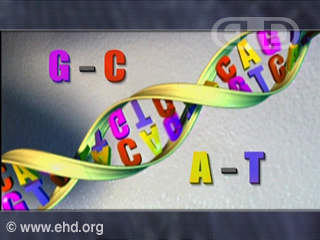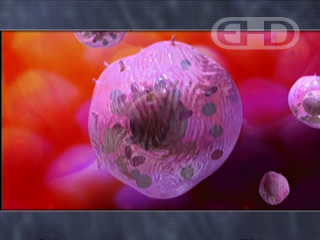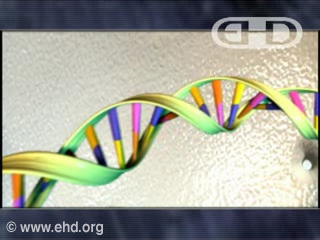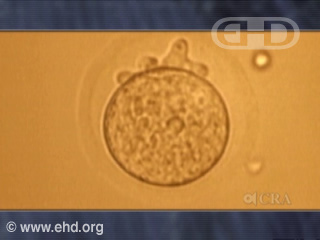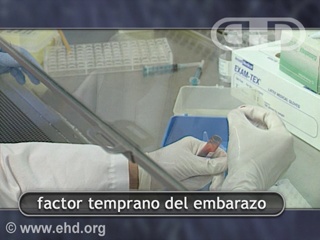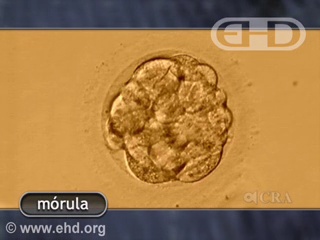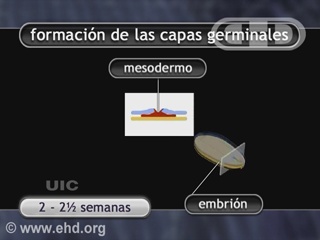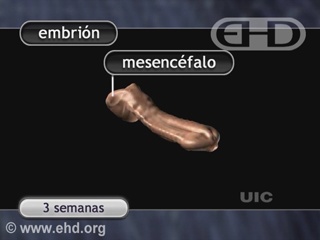| |
O Período Embrionário (As Primeiras 8 Semanas)
Desenvolvimento Embrionário: As Primeiras 4 Semanas
Capítulo 3 Fertilização
|
| |
| Biologically speaking,
"human development
begins at fertilization,"
when a woman and a man
each combine 23
of their own chromosomes
through the union
of their reproductive cells.
A woman's reproductive cell
is commonly called an "egg"
but the correct term is oocyte.
Likewise, a man's
reproductive cell
is widely known as a "sperm"
but the preferred term
is spermatozoon.
Following the release of
an oocyte from a woman's ovary
in a process called ovulation,
the oocyte
and spermatozoon join
within one
of the uterine tubes,
which are often
referred to as Fallopian tubes.
The uterine tubes
link a woman's ovaries
to her uterus or womb.
The resulting single-celled
embryo is called a zygote,
meaning "yoked or
joined together."
|
Capítulo 4 DNA, divisão celular e Fator Inicial da Gravidez (EPF)
|
| |
| The zygote's 46 chromosomes
represent the unique
first edition
of a new individual's
complete genetic blueprint.
This master plan resides
in tightly coiled
molecules called DNA.
They contain the instructions
for the development
of the entire body.
DNA molecules
resemble a twisted ladder
known as a double helix.
The rungs of the ladder are
made up of paired molecules,
or bases, called guanine,
cytosine, adenine, and thymine.
|
| Guanine pairs
only with cytosine,
and adenine with thymine.
Each human cell contains
approximately 3 billion
base pairs.
The DNA of a single cell
contains so much information
that if it were represented
in printed words,
simply listing the first letter
of each base
would require over 1.5 million
pages of text!
If laid end-to-end,
the DNA in a single human cell
measures 3 1/3 feet
or 1 meter.
|
| If we could uncoil
all of the DNA
within an adult's
100 trillion cells,
it would extend
over 63 billion miles.
This distance reaches from
the earth to the sun and back
340 times.
|
| Approximately 24 to 30
hours after fertilization,
the zygote completes
its first cell division.
Through the process
of mitosis,
one cell splits into two,
two into four, and so on.
|
| As early as 24 to 48 hours
after fertilization begins,
pregnancy can be confirmed
by detecting a hormone
called "early pregnancy factor"
in the mother's blood.
|
Capítulo 5 Estágios Iniciais (Mórula e Blastocisto) e Células Tronco
|
| |
| By 3 to 4 days
after fertilization,
the dividing cells of the embryo
assume a spherical shape
and the embryo is called
a morula.
By 4 to 5 days, a cavity forms
within this ball of cells
and the embryo is then called
a blastocyst.
The cells inside
the blastocyst
are called
the inner cell mass
and give rise to the head, body,
and other structures
vital to the developing human.
Cells within
the inner cell mass
are called embryonic stem cells
because they have the ability
to form each
of the more than 200 cell types
contained in the human body.
|
Capítulo 6 1 a 1½ Semanas: Implantação e Gonadotrofina Coriônica Humana (hCG)
|
| After traveling
down the uterine tube,
the early embryo
embeds itself
into the inner wall
of the mother's uterus.
This process, called
implantation, begins 6 days
and ends 10 to 12
days after fertilization.
Cells from the growing embryo
begin to produce a hormone
called human chorionic
gonadotropin, or hCG,
the substance detected
by most pregnancy tests.
HCG directs maternal hormones
to interrupt the normal
menstrual cycle,
allowing pregnancy to continue.
|
Capítulo 7 A Placenta e o Cordão Umbilical
|
| Following implantation,
cells on the periphery
of the blastocyst
give rise to part of
a structure called the placenta,
which serves as an interface
between the maternal
and embryonic
circulatory systems.
The placenta delivers
maternal oxygen, nutrients,
hormones, and medications
to the developing human;
removes all waste products;
and prevents maternal blood
from mixing with the blood
of the embryo and fetus.
The placenta also
produces hormones
and maintains embryonic
and fetal body temperature
slightly above that
of the mother's.
The placenta communicates
with the developing human
through the vessels
of the umbilical cord.
The life support capabilities
of the placenta rival those
of intensive care units
found in modern hospitals.
|
Capítulo 8 Nutrição e Proteção
|
| |
| By 1 week,
cells of the inner cell mass
form two layers called
the hypoblast
and epiblast.
The hypoblast gives rise
to the yolk sac,
which is one of the structures
through which
the mother supplies nutrients
to the early embryo.
Cells from the epiblast form
a membrane called the amnion,
within which the embryo
and later the fetus
develop until birth.
|
Capítulo 9 2 a 4 Semanas: Camadas Germinativas e Formação de Órgãos
|
| |
| By approximately 2 1/2 weeks,
the epiblast has formed
3 specialized tissues,
or germ layers,
called ectoderm,
endoderm,
and mesoderm.
Ectoderm gives rise
to numerous structures
including the brain,
spinal cord,
nerves,
skin,
nails,
and hair.
Endoderm produces the lining
of the respiratory system
and digestive tract,
and generates
portions of major organs
such as the liver
and pancreas.
Mesoderm forms the heart,
kidneys,
bones,
cartilage,
muscles,
blood cells,
and other structures.
|
| By 3 weeks
the brain is dividing
into 3 primary sections
called the forebrain,
midbrain,
and hindbrain.
Development of the respiratory
and digestive systems
is also underway.
|
| As the first blood cells
appear in the yolk sac,
blood vessels form
throughout the embryo,
and the tubular heart emerges.
Almost immediately,
the rapidly growing heart
folds in upon itself
as separate chambers
begin to develop.
The heart begins beating
3 weeks and 1 day
following fertilization.
The circulatory system
is the first body system,
or group of related organs,
to achieve a functional state.
|
Capítulo 10 3 a 4 Semanas: O Dobramento do Embrião
|
| |
| Between 3 and 4 weeks,
the body plan emerges
as the brain,
spinal cord,
and heart of the embryo
are easily identified
alongside the yolk sac.
Rapid growth causes folding
of the relatively flat embryo.
This process incorporates
part of the yolk sac
into the lining
of the digestive system
and forms the chest
and abdominal cavities
of the developing human.
|


